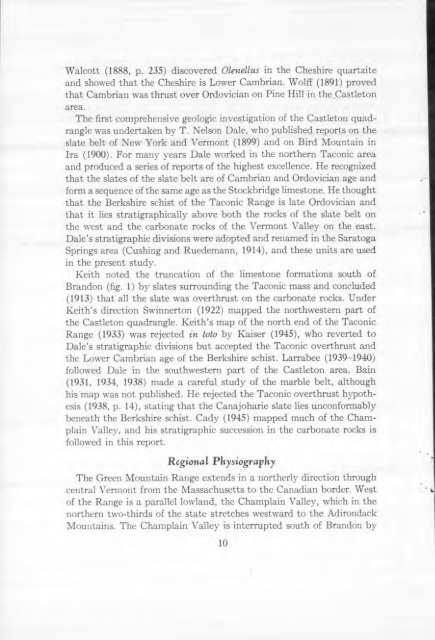STRATIGRAPHY AND STRUCTURE CASTLETON AREA VERMONT
STRATIGRAPHY AND STRUCTURE CASTLETON AREA VERMONT
STRATIGRAPHY AND STRUCTURE CASTLETON AREA VERMONT
Create successful ePaper yourself
Turn your PDF publications into a flip-book with our unique Google optimized e-Paper software.
Walcott (1888, p. 235) discovered Olenellus in the Cheshire (juartzite<br />
and showed that the Cheshire is Lower Cambrian. Wolff (1891) proved<br />
that Cambrian was thrust over Ordovician on Pine Hill in the Castleton<br />
area.<br />
The first comprehensive geologic investigation of the Castleton quadrangle<br />
was undertaken by T. Nelson Dale, who published reports on the<br />
slate belt of New York and Vermont (1899) and on Bird Mountain in<br />
Ira (1900). For many years Dale worked in the northern Taconic area<br />
and produced a series of reports of the highest excellence. He recognized<br />
that the slates of the slate belt are of Cambrian and Ordovician age and<br />
form a sequence of the same age as the Stockbridge limestone. He thought<br />
that the Berkshire schist of the Taconic Range is late Ordovician and<br />
that it lies stratigraphically above both the rocks of the slate belt on<br />
the west and the carbonate rocks of the Vermont Valley on the east.<br />
Dale's stratigraphic divisions were adopted and renamed in the Saratoga<br />
Springs area (Cushing and Ruedemann, 1914), and these units are used<br />
in the present study.<br />
Keith noted the truncation of the limestone formations south of<br />
Brandon (fig. 1) by slates surrounding the Taconic mass and concluded<br />
(1913) that all the slate was overthrust on the carbonate rocks. Under<br />
Keith's direction Swinnerton (1922) mapped the northwestern part of<br />
the Castleton quadrangle. Keith's map of the north end of the Tacon<br />
Range (1933) was rejected in toto by Kaiser (1945), who reverted t<br />
Dale's stratigraphic divisions but accepted the Taconic overthrust an<br />
the Lower Cambrian age of the Berkshire schist. Larrabee (1939-1940<br />
followed Dale in the southwestern part of the Castleton area. Bait<br />
(1931, 1934, 1938) made a careful study of the marble belt, although<br />
his map was not published. He rejected the Taconic overthrust hypothesis<br />
(1938, p. 14), stating that the Canajoharie slate lies unconformably<br />
beneath the Berkshire schist. Cadv (1945) mapped much of the Champlain<br />
Valley, and his stratigraphic succession in the carbonate rocks is<br />
followed in this report.<br />
Regional Physiography<br />
The Green Mountain Range extends in a northerly direction through<br />
central Vermont from the Massachusetts to the Canadian border. West<br />
of the Range is a parallel lowland, the Champlain Valley, which in the<br />
northern two-thirds of the state stretches westward to the Adirondack<br />
Mountains. The Champlain Valley is interrupted south of Brandon by<br />
10













